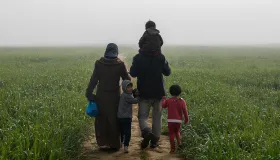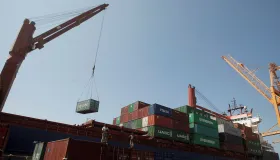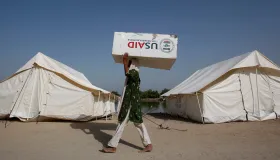Global Terrorism Trends
Explore terrorism trends through five data charts that help show the threat of terrorism around the world and how it has changed over time.
Teaching Resources—Terrorism: Introduction (including lesson plan with slides)
Higher Education Discussion Guide
Terrorism is a tactic that's long been used by extremists. Terrorism can be used in many different contexts, but it's normally a rare event in most countries.
However, sometimes terrorist attacks can increase in frequency due to multiple economic, social, political, and other factors. Areas particularly prone to terrorism are sometimes referred to as terrorism hot spots.
Policymakers can track some of those global dynamics by drawing on available databases, such as the Global Terrorism Database (GTD) managed by the University of Maryland. The GTD can be used to help understand evolving threats. Such databases can offer information about how terrorist threats have waxed and waned over decades. These patterns reveal useful data about how different countries have faced distinct security challenges over time.
Globally, cases of terrorism peaked around 2014
The 9/11 terrorist attacks in 2001 were particularly deadly, makingterrorism a headline issue in the United States. However, at that time, global terrorism was not experiencing overall growth. Rather, terrorist cases had risen internationally in the early and mid-1990s but had tapered by the early 2000s.
More than a decade after 9/11, however, terrorism peaked dramatically, as demonstrated in the chart below. During 2014, 13,463 recorded terrorist attacks [PDF] worldwide resulted in more than 32,700 deaths. One stark example: during a single terrorist event in 2014, al-Shabab militants attacked government offices, hotels, and a police station. The total death toll for this event reached forty-eight people.
Multiple factors drive terrorism, and researchers are still working to uncover the reasons terrorist actors can gain a foothold. For example, studies have found that fragile states with weak governance can provide an enabling environment for terrorist organizations. Fragile governments cannot effectively combat the threat of terrorism. Moreover, the factors that drive weak governance (such as corruption, economic instability, inequality, and marginalization) also drive extremism.
Even though overall peaks are sometimes dramatic, like the increased terrorist activity during the mid-2010s, terrorism isn’t distributed evenly across the world. Peaks can be driven by spikes in particular regions and linked to particular conflicts. For example, most terror attacks in the 2000s and 2010s occurred in just five “hot spot” countries.
Terrorism cases in Latin America rose in the 1980s and 1990s
In the decades leading up to the 9/11 attacks, the world experienced a rise in terrorist threats. During this period, Latin America saw a major spike in terrorism cases. The region served as a major global terrorism hot spot, and although cases have declined, terrorism remains a concern there today.
During the 1980s and 1990s, Latin America experienced more terrorist attacks (17,293) than all other regions combined (13,643).
The chart below displays how terrorist attacks plagued Colombia, Peru, Chile, Guatemala, Nicaragua, and El Salvador in the 1980s and early 1990s. Terrorism in some of those countries arose as left-wing organizations contested military dictatorships in places like Chile and Peru. Prominent terrorist groups at the time included the Shining Path in Peru, the Farabundo Marti National Liberation Front in El Salvador, and the Revolutionary Armed Forces of Colombia (FARC).
Although the threat of terrorism in Latin America today is relatively low by comparison, the region still faces challenges. Some groups, such as persisting dissident groups who evolved from the FARC in Colombia, continue to pose dangers. Terrorist threats know no borders, and can even travel between world regions. For example, by the start of 2018, more than two hundred foreign terrorist fighters from the Caribbean reportedly traveled to Iraq and Syria, contributing to violence in the Middle East.
Terrorism threats are rising in the Sahel
Today, experts are significantly concerned about rising cases of terrorism in the Sahel area of Africa, the semiarid region just south of the Sahara Desert. Over 40 percent of deaths from terrorism now occur in the Sahel.
The region has experienced many noteworthy attacks. Most notably, in 2015 and 2016, Islamist terror groups targeted a Radisson Blu Hotel in Mali, the Splendid Hotel in Burkina Faso, and L'Etoile du Sud Hotel in Ivory Coast.
Terrorist groups active in the Sahel include the Islamic State in the Greater Sahara, Jama’at Nusrat al-Islam wal Muslimeen, and the Islamic State in the West African Province (a group formerly known as Boko Haram).
Many common factors (weak governance, instability, ethnic discrimination) have contributed to the growth of those terrorist groups in the Sahel. However, experts also blame climate change for helping them gain a foothold.
The interconnection of climate change, conflict, and terrorism is particularly the case in the area around Lake Chad. The once-large lake has been drying up over the past couple of decades. As a result, a humanitarian crisis has emerged for many who have relied on it for crops and drinking water. Climate change’s effects exacerbate the issues faced by the more than seventeen million people living in areas affected by conflict-related violence in the Lake Chad region. The increasing deadliness of terrorism in the Sahel indicates a worrying trend of linkage between various threats to stability and human rights in the area.
Terrorism is becoming deadlier in Myanmar
Another context of concern for those working to address terrorism is Myanmar. Between 2015 and 2018, terrorism caused fewer than forty deaths in Myanmar. But, in the following four years, terrorism has claimed over eight hundred lives.
Myanmar became a particularly violent hot spot for terrorism following the military coup there in February 2021. After the democratically elected government was overthrown, former lawmakers and activists organized resistance groups to fight the military. Armed ethnic groups also oppose Myanmar’s military, which has responded to protests and resistance with brutal crackdowns.
Deaths from terrorism around the world have waned
Since 2015, the overall deadliness of terrorist attacks around the world has generally declined. In 2015, the world average peaked at around three deaths per attack. By 2021, that had dropped to fewer than two deaths per attack.
However, worrying data suggests that trend could be reversing. Terrorist attacks became slightly more deadly between 2021 and 2022.
That trend coincides with an increasing concentration of deaths due to terrorism. Now, fatalities are occurring in fewer countries. According to the IEP Global Terrorism Index (which analyzes terrorism in 163 countries covering 99.7 percent of the world's population), in 2015, at least one person died from terrorism in 33 percent of all tracked countries, while in 2022 terror deaths were limited to just 26 percent of countries.
In all, those five trends help illustrate just how complex the global terror threat landscape has been and remains today. The trends above show how those threats can evolve. Some positive signals such as a drop in cases in Latin America indicate that threats can and do decrease. This improvement is partially due to government responses that have addressed the many direct and indirect causes of violence. But worrying signs, such as rising cases of domestic terrorism in the United States, demonstrate the severity of the global terror threat. The need remains policymakers to continue to invest in security efforts to respond to evolving dangers. Among other evolving factors, the rise of new technology like artificial intelligence will shape how countries respond. Such elements raise new challenges and opportunities for countering terrorist threats as they continue to unfold today and in the future.









